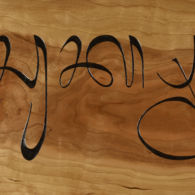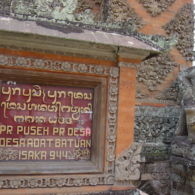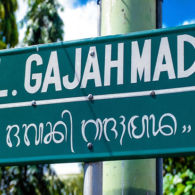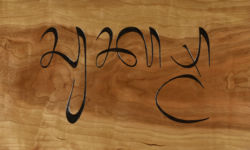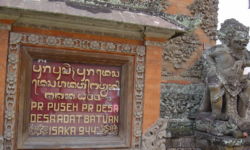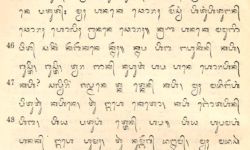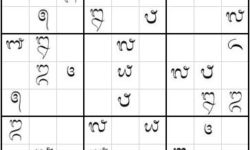Profile
The Balinese script is one of nearly 200 descendants of the Brahmi script, which first appeared in India some time before 500 BCE and steadily spread (partly through trade, partly through the spread of Hinduism and Buddhism) through South Asia, Southeast Asia, parts of East Asia, and what is now Indonesia.Brahmi reached Bali via the southern Indian Pallava script, which evolved into Kawi, or Old Javanese, between 800 and 1500 CE. Balinese (Aksara Bali) and its sister-script Javanese (Aksara Jawa) are among the most ornate and elaborate of the many scripts of Indonesia. In historical handwritten documents, in fact, Javanese and Balinese are virtually identical. The fact that there is a difference nowadays is actually due to the influence of Dutch typefaces for Javanese that were influenced by European copperplate writing.
Early Balinese writing was inscribed into stone, or written on lontar palm leaves bound into lontar books, especially religious and ceremonial materials. The culture’s respect for these texts, and for writing in general, can be seen by the fact that the calendar includes a holy day (named for Saraswati, the Hindu goddess of knowledge, music, art, wisdom, and learning) when Balinese people get out, clean and revere their own lontar collections.
Balinese script can also still be seen on public signage on roads, at entrances to villages, and on government buildings and temples. Neighborhood reading groups called Sekaha Pesantian also exist for the purpose of reading the Balinese script in a social context.
One Balinese wrote: “My father is a member of sekaha pesantian in our banjar. As a kid, I followed him [when he] went to the sekaha reading sessions. The situation was similar to the one in a karaoke room, everyone is eager to take turn reading. In one turn, there were three people participating; one reading (sounds more like singing) the Kawi text, one translating to Balinese, and the last one telling the description about the meaning or the moral story of the verse. Of course the singing part is the most exciting one that also requires the higher skills. Those sessions can take hours, even from dusk until dawn” (Ida Bagus Adi Sudewa).
Two factors dramatically reduced the use of the Balinese script. During World War II, when the Dutch East Indies were occupied by the Japanese, the use of many indigenous scripts was prohibited. After the war, when Indonesia achieved independence, the official language became Indonesian, a form of Malay, generally written in the Latin alphabet. Within two generations, the number of Balinese who read and write their traditional script has been drastically reduced to the point where even though the script is still used in religious ceremonies and documents, few younger Balinese can understand it even though it is still taught, to a certain extent, in schools.
Even the small amount of official teaching — as little as two hours a week — has little effect. Students report a popular saying, malajah basa bali, macane takutin which has the double meaning, “learning Balinese language, we are afraid of the reading part” and “learning Balinese language, we are afraid of tiger.”
All the same, since 2015 a sense of the importance of the Balinese script (and indeed the spoken Balinese language, which has been supplanted by Indonesian for official purposes) has led to the development of a number of organizations dedicated to its preservation and revival, notably BASABali, Aksara Di Nusantara and the Hanacaraka Society.
The new governor of Bali, Wayan Koster, declared that every Thursday be a Traditional Thursday, on which all Hindus working in government offices should wear traditional Balinese dress and speak Balinese. The ruling would also be in force on other celebratory days during the year.
There are reading, writing and speaking competitions in Balinese and Balinese script for school age children, and a new law requires public signs to be in Balinese language and script as well as Indonesian — though there have been some notable and embarrassing mistakes when sign-painters did not know the script quite as well as the authorities might have hoped.
“The aim is to preserve our cultural heritage, especially in relation to literacy, which is a cultural identity of Bali,” Koster said. “I think Balinese letters, Balinese text is in our identity, a symbol of our civilization.”
You can help support our research, education and advocacy work. Please consider making a donation today.
Links
General script, language, and culture resources
- Omniglot
- Wikipedia
- Unicode (PDF)
- Contemporary Use of the Balinese Script (PDF)
- Scriptsource
Community support
- Learn Balinese Language Facebook Group
- Palm Leaf Manuscripts
- Hanacaraka Society community museum
- YouTube video about the Hanacaraka Society community museum
- Indonesian literature — history, humour and language
Font and keyboard resources
- https://itunes.apple.com/us/app/balinese-font-and-keyboard/id916653549?mt=8
- https://lindenbergsoftware.com/en/keyboards/balinese/
- https://www.fontspring.com/fonts/schizotype/bali-script
- https://smartfonts.com/aksara-bali-galang.font
- http://www.babadbali.com/aksarabali/balisimbar.htm
- https://www.google.com/get/noto/#sans-bali
Gallery

Sponsor
“I wish to express my support for those who are working to strengthen the use of the Balines script, both for Basa Bali and for the neighbouring Base Sasak language.”
—Peter K Austin

